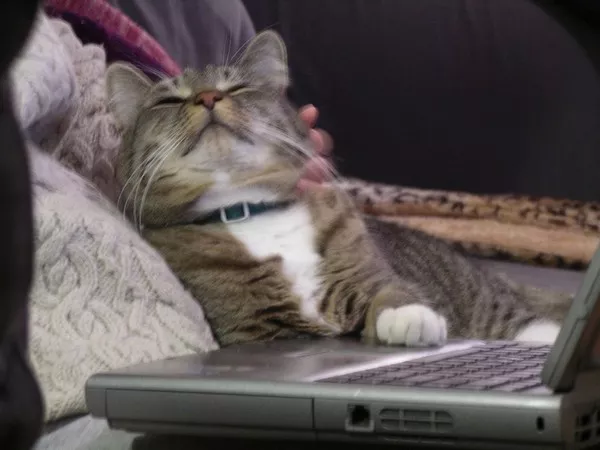Ensuring the health and well-being of your feline companion is a primary concern for every cat owner. Cats, known for their independence and subtle behaviors, often require close observation to determine their health status. Recognizing the signs of a healthy cat can help owners identify potential issues early and maintain their cat’s optimal health. This comprehensive guide will explore the various signs that indicate a healthy cat, providing detailed insights into their physical, behavioral, and emotional well-being.
Physical Signs of a Healthy Cat
1. Shiny and Smooth Coat
A cat’s coat is a significant indicator of its overall health. A healthy cat will have a shiny, smooth, and clean coat. Regular grooming, either by the cat itself or with the help of the owner, ensures that the fur remains free from mats and tangles. The absence of bald patches, excessive shedding, or flaky skin is also a good sign of a healthy coat.
2. Clear and Bright Eyes
Healthy cats have clear, bright eyes without any discharge, redness, or cloudiness. The pupils should be of equal size, and there should be no signs of excessive tearing or squinting. The third eyelid, a protective membrane, should not be visible.
3. Clean Ears
A healthy cat’s ears are clean and free from any discharge, odor, or excessive wax. The inner part of the ears should be a pale pink color. Cats with healthy ears should not display any signs of scratching, shaking their head excessively, or tilting their head to one side.
4. Healthy Weight
Maintaining an appropriate weight is crucial for a cat’s health. A healthy cat should have a well-proportioned body with a visible waistline when viewed from above. You should be able to feel the ribs without pressing too hard, but they should not be overly prominent.
5. Good Dental Health
Healthy cats have clean teeth and gums without any signs of tartar buildup, bad breath, or gum inflammation. Their gums should be a healthy pink color, and they should not exhibit any signs of drooling, difficulty eating, or pawing at their mouth.
6. Strong and Clear Nails
A healthy cat has strong, clear nails that are free from cracks, splits, or discoloration. Regular nail trimming and scratching on appropriate surfaces help maintain nail health and prevent issues like ingrown nails or infections.
7. Normal Bowel Movements and Urination
Observing your cat’s litter box habits can provide valuable insights into their health. Healthy cats produce firm, well-formed stools without any signs of diarrhea, constipation, or blood. They should urinate regularly, with clear to light yellow urine, and show no signs of straining or discomfort.
Behavioral Signs of a Healthy Cat
1. Normal Appetite
A healthy cat has a consistent and normal appetite. They should show interest in their food, eat regularly, and not display signs of excessive hunger or loss of appetite. Sudden changes in eating habits can indicate underlying health issues and should be monitored closely.
2. Regular Grooming
Cats are known for their grooming habits. A healthy cat grooms itself regularly, keeping its coat clean and free from dirt and debris. Excessive grooming, which can lead to bald spots or sores, or a lack of grooming, which can result in a dirty and matted coat, may indicate health problems.
3. Active and Playful
Healthy cats are active and playful, displaying curiosity and interest in their surroundings. They should engage in regular play, interact with toys, and show normal levels of energy. A sudden decrease in activity or lethargy can be a sign of illness.
4. Social Behavior
A healthy cat displays normal social behavior, including seeking interaction with their owners and other pets. They should show affection, such as purring, rubbing against you, or kneading. Conversely, excessive hiding, aggression, or changes in temperament can be indicators of stress or illness.
See Also: Will a Healthy Cat Starve Itself?
Emotional and Psychological Signs of a Healthy Cat
1. Contentment and Relaxation
Healthy cats often display signs of contentment and relaxation. They may purr, stretch, and knead when they feel comfortable and secure. A cat that frequently shows these behaviors is likely in good emotional health.
2. Normal Sleep Patterns
Cats sleep a lot, typically between 12 to 16 hours a day. Healthy cats have consistent sleep patterns and should not exhibit signs of restlessness or insomnia. They should have preferred sleeping spots and routines that they follow regularly.
3. Positive Interaction with Environment
Healthy cats explore their environment confidently. They should use scratching posts, play with toys, and find comfortable resting spots. They should not be overly fearful or anxious about their surroundings.
Preventative Health Measures
1. Regular Veterinary Check-Ups
Routine veterinary visits are essential for maintaining a cat’s health. Regular check-ups help detect potential health issues early and ensure that your cat receives necessary vaccinations, dental care, and parasite prevention treatments.
2. Balanced Diet
Providing a balanced and nutritious diet is crucial for a cat’s health. Ensure that your cat’s food meets all their nutritional requirements and is appropriate for their age, weight, and health status. Fresh water should always be available.
3. Exercise and Enrichment
Regular exercise and mental stimulation are important for a cat’s physical and psychological well-being. Provide interactive toys, climbing structures, and opportunities for play to keep your cat active and engaged.
4. Dental Care
Regular dental care, including brushing your cat’s teeth and providing dental treats or toys, helps maintain oral health. Schedule professional dental cleanings as recommended by your veterinarian.
5. Parasite Prevention
Consistent parasite prevention, including treatments for fleas, ticks, and worms, is essential. Regularly check your cat for signs of parasites and follow your veterinarian’s recommendations for preventive care.
Recognizing Early Signs of Health Issues
1. Changes in Appetite or Weight
Sudden changes in appetite or unexplained weight loss or gain can be early signs of health issues. Monitor your cat’s eating habits and weight regularly and consult your veterinarian if you notice significant changes.
2. Changes in Grooming Habits
A decrease in grooming can indicate health problems such as arthritis or dental issues, while excessive grooming may be a sign of stress or skin conditions. Pay attention to changes in your cat’s grooming behavior.
3. Behavioral Changes
Behavioral changes, such as increased aggression, withdrawal, or vocalization, can be signs of underlying health issues. Monitor your cat’s behavior closely and seek veterinary advice if you notice significant changes.
4. Litter Box Issues
Changes in litter box habits, such as frequent urination, straining, or inappropriate elimination, can indicate urinary tract infections, kidney disease, or other health problems. Regularly clean the litter box and monitor your cat’s elimination habits.
5. Respiratory Issues
Signs of respiratory issues, such as coughing, sneezing, or difficulty breathing, should be addressed promptly. These symptoms can indicate respiratory infections, allergies, or more serious conditions.
Conclusion
Recognizing the signs of a healthy cat involves observing their physical appearance, behavior, and emotional well-being. By understanding and monitoring these indicators, you can ensure your cat remains healthy and happy. Regular veterinary care, a balanced diet, and providing a stimulating environment are key to maintaining your cat’s health. Always consult your veterinarian if you have concerns about your cat’s health, as early detection and intervention are crucial for addressing potential health issues.























